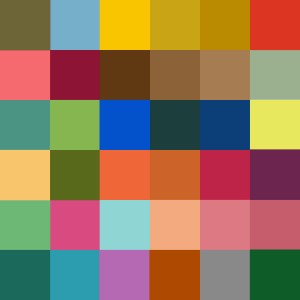“The Marvelous Art of Jack Kirby” will be exhibited by the Hunterdon Art Museum in Clinton, New Jersey from 28 March through 16 May 2010.
During the opening at 2pm on Sunday, 28 March, artist/instructor/collector (and Kirby Museum member) Charles David Viera will present a gallery talk where he will speak of the many contributions that Jack Kirby has made to American Pop Culture and offer insight to the artwork in the exhibition.
Below is a list of pieces being exhibited. The list is currently incomplete, though; some story page details need to be verified, a Fantastic Four page with ink art by Joe Sinnott is not included.
Stuntman: “Curtain Call for Death!” page 7, 1946
Story and script by Jack Kirby and Joe Simon. Pencil art by Jack Kirby. Ink art by Joe Simon and Jack Kirby. Lettering art by Howard Ferguson
First published: Stuntman Comics 2, June 1946 (Harvey Comics).
Bulls-Eye: “Grandma Tomahawk” page XX, 1954
Story and script by Jack Kirby and Joe Simon. Pencil art by Jack Kirby. Ink art by Joe Simon and Jack Kirby. Lettering art by Ben Oda.
First published: Bulls-Eye 5, April 1955 (Mainline Comics).
Sky Masters of the Space Force: “Mayday Shannon” strip 46, 1958
Story by Jack Kirby, Dick Wood and Dave Wood. Pencil Art by Jack Kirby. Ink art and lettering art by Wallace Wood.
First published: Sky Masters of the Space Force, 30 April 1959 (Adams Syndicate).
Two-Gun Kid: “The Outlaw” page XX, 1960
Story by Jack Kirby with Stan Lee. Pencil art by Jack Kirby. Script by Stan Lee. Ink art by Dick Ayers. Lettering art by XX.
First published: Two Gun Kid 55, August 1960 (Marvel Comics).
Fantastic Four: “The Micro-World of Doctor Doom!” page 12, 1963
Story by Jack Kirby with Stan Lee. Pencil art by Jack Kirby, Script by Stan Lee, Ink art by Dick Ayers. Lettering art by Artie Simek.
First published: Fantastic Four 16, July 1963 (Marvel Comics).
X-Men: “Enter, The Avengers” page 8, 1964
Story by Jack Kirby with Stan Lee. Pencil art by Jack Kirby, Script by Stan Lee, Ink art by Chic Stone. Lettering art by Sam Rosen.
First published: X-Men 9, January 1965 (Marvel Comics).
Thor: “The Grandeur and the Glory!” page 3, 1965
Story by Jack Kirby with Stan Lee. Pencil art by Jack Kirby, Script by Stan Lee, Ink art by Vince Colletta, Lettering art by Artie Simek.
First published: Journey Into Mystery 124, January 1966 (Marvel Comics).
Thor: “The Grandeur and the Glory!” page 5, 1965
Story by Jack Kirby with Stan Lee. Pencil art by Jack Kirby, Script by Stan Lee, Ink art by Vince Colletta, Lettering art by Artie Simek.
First published: Journey Into Mystery 124, 1966 (Marvel Comics).
Thor: “The Grandeur and the Glory!” page 11, 1965
Story by Jack Kirby with Stan Lee. Pencil art by Jack Kirby, Script by Stan Lee, Ink art by Vince Colletta, Lettering art by Artie Simek.
First published: Journey Into Mystery 124, 1966 (Marvel Comics).
Captain America: “The Secret!” page 6, 1966
Story by Jack Kirby with Stan Lee. Pencil art by Jack Kirby. Script by Stan Lee. Ink art by Frank Giacoia. Lettering art by Artie Simek.
First published: Tales of Suspense 86, February 1967 (Marvel Comics).
Captain America: “In The Name of Batroc!” page 7, 1968
Story by Jack Kirby with Stan Lee. Pencil art by Jack Kirby, Script by Stan Lee, Ink art by Dan Adkins. Lettering art by Sam Rosen.
First published: Captain America 105, September 1968 (Marvel Comics).
Forever People: “Super War” page XX, 1970
Story, script and pencil art by Jack Kirby. Ink art by Vince Colletta. Lettering art by John Costanza.
First published: Forever People 2, April 1971 (DC Comics).
Soul Love: “The Teacher!” page 6
Story, script and pencil art by Jack Kirby. Ink art by Vince Colletta. Lettering art by John Costanza.
Unpublished. Produced for Soul Love 1, 1971 (DC Comics).
Soul Love: “The Teacher!” page 7
Story, script and pencil art by Jack Kirby. Ink art by Vince Colletta. Lettering art by John Costanza.
Unpublished. Produced for Soul Love 1, 1971 (DC Comics).
Soul Love: “The Teacher!” page 8
Story, script and pencil art by Jack Kirby. Ink art by Vince Colletta. Lettering art by John Costanza.
Unpublished. Produced for Soul Love 1, 1971 (DC Comics).
In The Days of the Mob: “XX” page 6, 1971
Story, script and pencil art by Jack Kirby. Ink art and lettering art by Mike Royer.
Unpublished. Produced for In The Days of the Mob 2, 1972 (DC Comics).
Kamandi: “The Devil’s Arena” page 21, 1972
Story, script and pencil art by Jack Kirby. Ink art and lettering art by Mike Royer.
First published: Kamandi, The Last Boy on Earth 4, March 1973 (DC Comics)
The Eternals: “The Devil In New York” page 14, 1976
Story, script and pencil art by Jack Kirby. Ink art by John Verpoorten. Lettering art by John Costanza.
First published: The Eternals 3, September 1976 (Marvel Comics).
Machine Man: “Quick Trick” page 1, 1978
Story, script and pencil art by Jack Kirby. Ink art and lettering art by Mike Royer.
First published: Machine Man 6, September 1978 (Marvel Comics).
Superman & Challengers of the Unknown: “Give Me Power, Give Me Your World!” page 15, 1985.
Story and script by Bob Rozakis. Pencil art by Jack Kirby. Ink art by Greg Theakston. Lettering art by John Costanza.
First published: DC Comics Presents 84, August 1985 (DC Comics).
Additional events hosted by the Hunterdon Art Museum in conjunction with the exhibit:
1 – a lecture titled “Appreciation of Comic Art” presented by Joseph Mannarino on Saturday, 10 April at 12 noon.
2 – Doug Baron will teach a Beginner Comic Book Illustration Class for adults (16 and over) April 19-May 17. `
Hunterdon Art Museum on Google Maps























